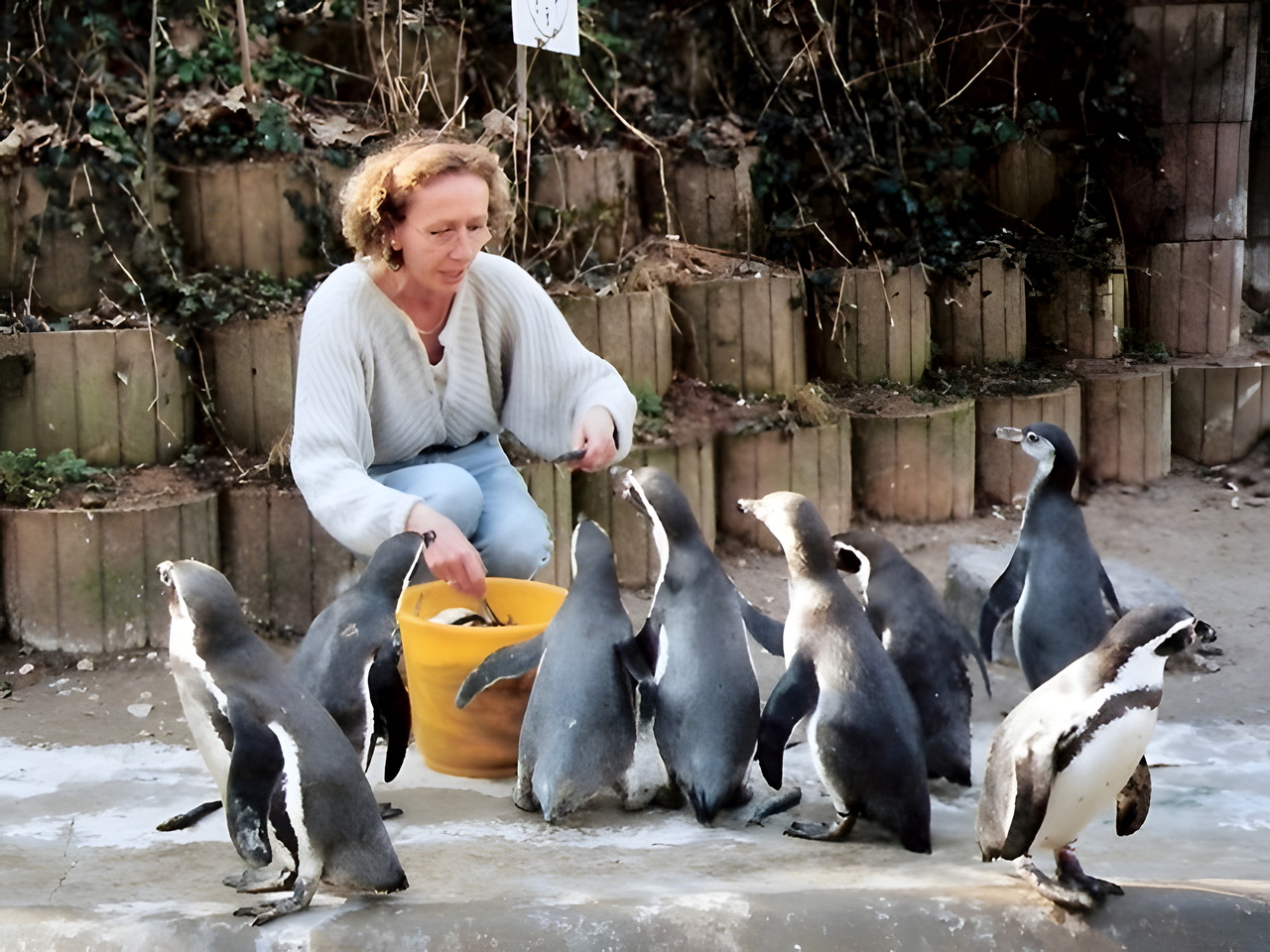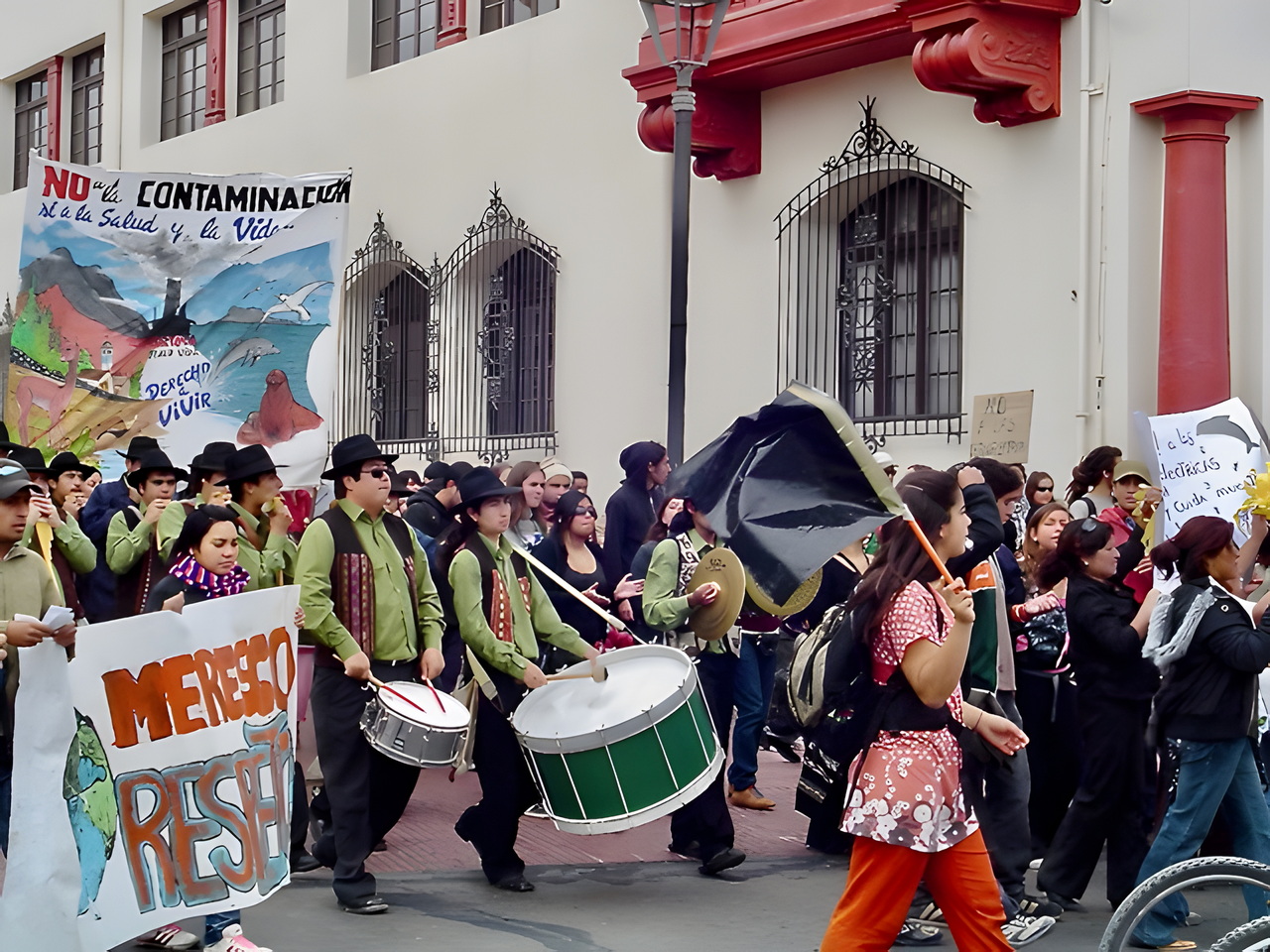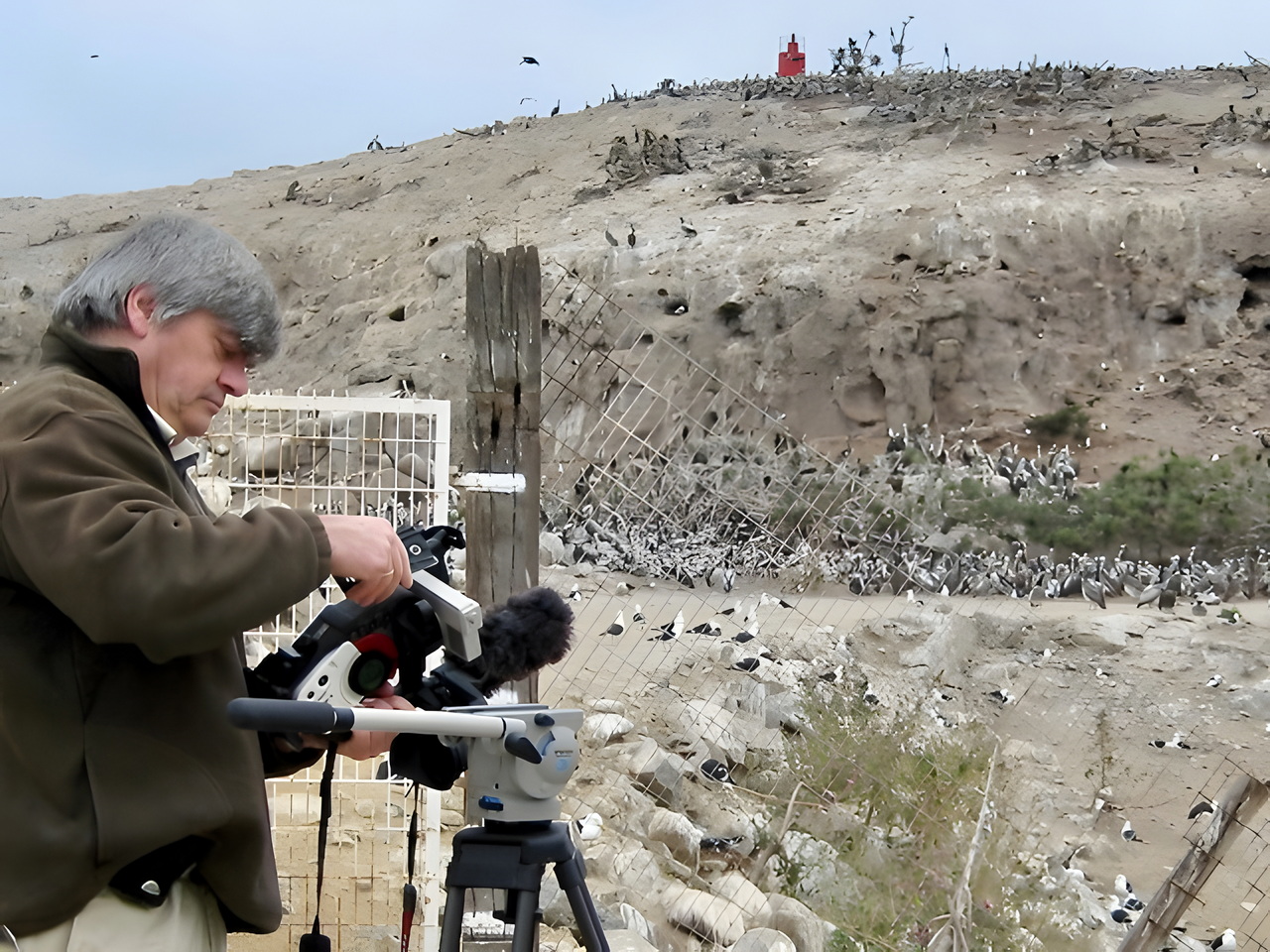A "Wacky" Idea Becomes Reality
Sphenisco
Sphenisco – Conservation of the Humboldt-Penguin
The history of Sphenisco e.V.
The article "A Wacky Idea Becomes Reality" tells the story of Sphenisco and recalls films about Humboldt penguins and species conservation that accompanied the development of the association. In the following five chapters, you will learn how it all began and how the club has developed. The "wacky idea" was published in November 2025 in the Heimat-Jahrbuch 2026 of the Südliche Weinstrasse district of Germany. The 2026 yearbook was dedicated to the topic of "Stage and Screen in the Southern Palatinate". Have fun reading. 🐧
Translated by Erich Greiner- An Annual Ticket for the Zoo
- Observations in Chile
- Unusual Association Founding
- There is Nothing Good. Unless You Do It
- Sphenisco Today
An Annual Ticket for the Zoo
In life, there are actions or situations that at first seem small and insignificant, but over time they take on a completely unexpected meaning. No one could have guessed what it would lead to when Werner Knauf gave his wife an annual ticket for the Landau Zoo. During one of her visits, she discovered that penguins were born at the zoo, which had to be fed by an animal keeper and cared for all day. Gabriele Knauf wanted to know what these chicks, which were called "Hercules", "Mickerich" and "Würmchen", were all about and whether they survived. "When I observed the feeding of three hand-reared Humboldt penguins at Landau Zoo in December 1991, I did not know that this species is one of the three most endangered penguin species in the world. I also didn't know that hand-rearing is sometimes a necessary measure in a zoo to support natural rearing or to make it successful in the first place. When a demanding peeping sounded from a cave in January 1992, a time began for me in which I and their animal keepers feared for the survival of some chicks. Since then, until May of 1994, I spent at least half an hour at feeding times in front of the penguin enclosure on about 600 days. In critical situations, it was sometimes an hour and a half.
The main object of observation for me was the rearing of the young up to their independence. I was able to follow this process on five young penguins who grew up without human intervention. Of a total of four hand-reared animals, two have now been weaned from their human parents, and one seems to be in the process of making it on his own two feet at the moment. It is especially nice for me to see the grown up "little ones" now breeding and raising chicks themselves. Along the way, the love life of the colony and thus the gender distribution became clearer to me. During the observation period, there was no divorce among the breeding pairs, although, albeit very rarely, there were small infidelity attempts. Once even a young-raising mother seemed to get involved with a handsome penguin male who was otherwise attached, which accordingly worried the zookeepers and me. The matter ended well. The rearing was not disturbed. It remained a small "adventure away from home". (1)
Gabriele Knauf observed and documented the development of the Landau colony and the behaviour of the penguins for many years, especially the breeding and care behavior. Her husband discovered the sympathetic birds as an attractive motif and supported his wife with film footage. Together with a colleague, the couple used the footage to document the growth of a penguin in 1998. In "Pengu Einstein - A Youth in the Zoo" they let the protagonist have his say: "My name is Einstein and I am a Humboldt Penguin and also a true Landauer. Here I swim, here I waddle, here I hatched from an egg and have now become a real penguin man. Ilse, Gabriele and Werner made this film about my childhood and youth at the zoo. Oh yes, that's unique in the world! A film about the first years of a Humboldt penguin's life. And the three even received a prize for this, at the Naturale 2000. Isn't that great?" (2)
The intensive observations repeatedly led to new questions. Since some of them could not be answered at the zoo, Gabriele Knauf called the Kiel Institute of Oceanography and came across Guillermo Luna, a Chilean doctoral student, who invited her and her husband to a meeting with his doctoral supervisor, Prof. Culik. At the meeting in Kiel, the scientists suggested that the two Landauer participate in research work in Chile. A completely surprising, unusual proposal.
Observations in Chile
Gabriele and Werner Knauf accepted the invitation, travelled to Chile, worked with researchers and the Fundación Otway (3), observed and filmed Humboldt penguins in very different places, in the Pan de Azúcar National Park, the penguin island of Puñihuil in Chiloe, but above all on the island of Pajeros Niños in Algarrobo. As before in the zoo, Gabriele Knauf observed systematically and compared the results with those in the zoo. In 2002, the couple processed the footage of Pan de Azúcar into the story "Pepe in Distress - Vulture Gonzalez Reports". In German and Spanish, they told the story in a child-friendly way: "... Vulture Gonzales and his friend Pepe, the Humboldt Penguin. … Pepe has a lot of stress: he has to get food for his two chicks, which he is currently raising. In the search for fish, he is always in great danger. Gonzales wants to help Pepe. He has learned from scientists that his friends, the Humboldt penguins, are threatened with extinction. He is making an urgent appeal to the very top, namely to the President of Chile." (4) (5)
In 2005, Gabriele and Werner Knauf condensed the beauty and diversity of the breeding island of Puñihuil off the island of Chiloe into the German and English-language documentary "Naturparadies Puñihuil". (6) (7) In 2006, they showed in "Marine Protected Zone Puñihuil – A Future for All Inhabitants?" the danger that bycatch poses to Humboldt penguins and other marine animals and how vulnerable the little paradise is. (8) (9)
The island of Pajeros Niños in Algarrobo was visited most frequently by the two Landauer. In 2014, after the founding of the Sphenisco Association, they presented penguin friends with the sum of their knowledge from 14 years of observations and a best of the recordings in the documentary "The Hour of the Penguins": "... We get to know the Humboldt Penguin as an excellent climber, as a running artist. The clumsy waddling gait becomes a skillful movement that protects the joints and avoids injuries. Trumpets and trombones, machos demonstrate their masculinity. Through beak blows and wing flapping without touching the opponent, penguins gain respect without hurting the other. Penguin couples maintain their relationship usually their entire lives. Parents take care of their young. We see the animals and understand their behavior, thanks to the entertaining explanations. Fighting, pinching, diving, playing in the evening sun, that's also part of a penguin's life. ...” (10)
Unusual Association Founding
During one of the trips, at the end of 2007, Chilean environmentalists and scientists asked Gabriele and Werner Knauf for support against global players such as the Chilean state-owned company Codelco (11), the French company Suez Energie and the Chilean company CMP (11). At that time, the companies were planning three coal-fired power plants in the immediate vicinity of the "Reserva Nacional Pingüino de Humboldt" (12) in northern Chile. Almost everyone, including committed conservationists, was of the opinion that "there is no chance against these overpowering companies". However, the environmentalists on site, including the citizens' initiative MODEMA (13) and the two Landauers, wanted to at least try. Gabriele and Werner Knauf called on friends, acquaintances, zoological gardens and their staff to protest against the destruction of the globally important ecosystem in northern Chile in personal letters to Chilean President Bachelet: "We appeal to you, dear Madam President, to prevent the construction of the power plants at the planned locations and to work towards an ecologically and socially acceptable solution." The penguin friends informed in zoological gardens about the current conflict as well as other causes of threat and also collected signatures against the construction of the power plants with lists and an online petition.
In conversations with those responsible in Chile, the two Landau residents were regularly asked who they were and who they spoke for. A legitimate question that particularly annoyed Gabriele Knauf. In order to give the personal protest more weight and ultimately continuity, the two decided to found an association. They found idealistic comrades-in-arms in some zoological gardens and among former volunteers who had lost their hearts to Humboldt penguins in Chile. June 7, 2008 was the "hatching date". Representatives from zoological institutions (14), including the Landau Zoo, the Landau Zoo Circle of Friends (an association supporting the Landau Zoo) and the Landau Zoo School, a total of 34 people, founded Sphenisco. Among the founding members was Rosa Rojas, the chairwoman of the Chilean citizens' initiative MODEMA (13). Gabriele Knauf was elected chairperson. She was then confirmed as president five times and remained so until her death in 2023. The founders set out to develop media for environmental education, organize international protests, prepare volunteers and financially support the work in situ.
There is Nothing Good. Unless You Do It. (15)
The preservation of the "National Protected Area" (12) or the "Humboldt Archipelago" has been the focus of the association's activities from the very beginning and still is today. The protection of this ecosystem has become Sphenisco's DNA, so to speak. When financial resources allowed, the association hired Nancy Duman in 2016 to support the protests of civil society groups on the ground. With the environmental organization "Save the Rainforest", the association collected 27,000 signatures and handed them over to President Sebastián Piñera and the President of the Regional Government Coquimbo. The impossible became reality. First, the company Codelco (11) withdrew its project, the company CMP (11) was prohibited by the navy from using the coast and the incumbent president Piñera suspended the permit for the company Suez Energie in 2010. The common people, citizens of the municipality of La Higuera, scientists and conservationists triumphed over economic giants, saved jobs and saved a unique ecosystem from destruction. The weight and scope of the protests are difficult to assess. The reasons for the withdrawal of the company Codelco (11) remained unknown, as did the reasons of the Navy for its no. President Piñera – as it turned out later – did not prove to be the nature conservationist he claimed to be: "We don't want to destroy such a beautiful area, let's enjoy the nature there". In 2021, the Pandora Papers revealed that he was pursuing his own interests as a co-owner of the "Dominga" mine.
In 2010, Gabriele and Werner Knauf visited Señora Milagros Ormeño B. and Señor Helbert Anenante H., both active members of the NGO, Acorema, (16) in Peru. It was agreed to cooperate in environmental education. The first programme, "We Want to Live", was aimed primarily at pupils and fishermen in the coastal communities of San Andrés and Paracas in the Ica region.
The consideration for the valuable ecosystem "Humboldt Archipelago" did not last, and in 2014 it was threatened again. The companies CMP (11) and Andes Iron planned two loading ports for iron and copper ore in the immediate vicinity. Since then, the civil society groups on the ground and Sphenisco have not been able to rest. Again and again, they were and are forced to mobilize fellow citizens and sue against notices or building permits. Sphenisco and "Save the Rainforest" again collected signatures: "With my signature, I join the appeal of Sphenisco e.V. to President Michelle Bachelet against the construction of ports and for the creation of the marine protected area "La Higuera and Chañaral Island", Coquimbo region, northern Chile". The petition "Save 26,000 Humboldt Penguins" was joined by 227,857 people, and the petition "Urgency for a Protected Area for Humboldt Penguins" was joined by another 139,797 people. The total of 357,000 signatures from all over the world contributed to the fact that in 2017 the regional government in Coquimbo and later also the Bachelet government rejected the mining and port project of the company Andes Iron. To this day, the companies CMP (11) and Andes Iron are trying to enforce permits for the loading ports with fake news and lawsuits. So far, environmentalists have succeeded in preventing the construction of the ports. After 15 years, it was even possible to finally better protect the "Humboldt Archipelago" in 2023. The Boric government declared the particularly valuable ecosystem a "protected zone with various uses".
Sphenisco Today (as of: 2025)
Today, Sphenisco has 111 members, 85 natural persons and 26 institutions. An unusually large number of members, around 20 percent, work continuously, translate texts, maintain the trilingual website, organize information events, and around 30 percent participate in general meetings. Some have even advertised for species conservation in a highly creative way with animal books (17) (18), comics (19), pictures (20) and the art and wine project "Art Sphenisco" (21). European zoos that want to make a contribution to the protection of the Humboldt Penguins and their habitat do so exclusively with the help of the Landau Association and make large sums available. The generous funding is made possible by the so-called "species protection euro", which more and more zoological gardens levy. The donations enable long-term and large projects such as:
- Scientific studies on the population, breeding success and foraging in Chile. The Research work is scheduled to run for six years and is largely carried out by the Scientists Dr. Alejandro Simeone and Dr. Guillermo Luna.
- Scientific surveys on population and breeding success on the Ballestas Islands in Peru, the by Señora Milagros Ormeño B., Acorema (16).
- Continuous environmental education in southern Peru, also led by Señora Milagros Ormeño B. and her team from Acorema (16). The training measures are geared towards local populations in the vicinity of important breeding colonies, in order to increase their involvement and to raise awareness of protection.
- Continuous public relations and educational work in the Coquimbo region, Chile, which is carried out by Señora Nancy Duman and her team. Currently, the focus for the environmentalists is on designing the management plan for the 2023 marine protected area "Humboldt Archipelago". In order to increase the commitment to the valuable ecosystem the team advertises with various, very creative campaigns such as
- the literary competition "the Humboldt Archipelago with 110 words",
- the weekly video podcast Sintonía Humboldt,
- the murals in villages on the topic of "Humboldt Penguins in the Neighbourhood",
- the travelling photo exhibition "Humboldt Archipelago",
- the dissemination of didactic teaching material on the "Humboldt Archipelago",
- natural history hikes, and
- the construction of information points in the village of Chungungo and at Yerba Buena.
In addition, the team continuously advocates for the preservation of the "Humboldt Archipelago" and its sustainable use in audiences with representatives of all regional and local authorities, governors and consultants.
An impressive package of measures. Over the years, the small Landau association has become an important partner in nature and species conservation on site, in the Chilean region of Coquimbo and the Peruvian region of Ica. Has Sphenisco achieved its goals? Yes and no. The effect of the support is difficult to assess. The association certainly contributed to Chilean environmentalists being able to prevent the destruction of the "Humboldt Archipelago" and to expanding protection in Chile and Peru. More generally, Sphenisco contributed to the fact that the Humboldt penguin still exists. However, it is also true that the goal of preserving the Humboldt penguin and its habitat has not been conclusively achieved. The Humboldt penguins and their habitat are still highly threatened.
W.K., Landau April 2025
Translated by Erich Greiner
- Pingu Einstein – Eine Jugend im Zoo (German). 1998
https://vimeo.com/1073200818 - Pepe in Not – Geier Gonzalez berichtet (German). 2002
https://vimeo.com/133258844 - El pingüino Pepe en peligro – Un reporte jote Gonzalez (Spanish). 2002
https://vimeo.com/133357080 - Naturparadies Puñihuil (German). 2005
https://vimeo.com/1073506756 - Natural Paradise Puñihuil. 2005
https://vimeo.com/1078639169 - Meeresschutzzone Puñihuil – Eine Zukunft für alle Bewohner (German)? 2006
https://vimeo.com/1073850219 - Reserva Marina Puñihuil – Un futuro para todos los habitantes (Spanish)? 2006
https://vimeo.com/1074571830 - Die Stunde der Pinguine (German). 2010
https://vimeo.com/84377067 - Help the Humboldts: Flaschenpost. Trickfilm (German). Nicole Bertram
https://vimeo.com/337390003







